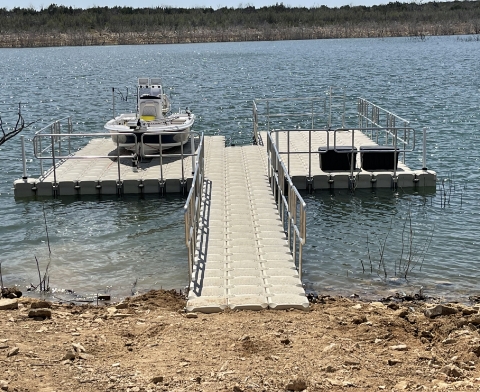Create the Perfect Docking Remedy With Floating Docks
Floating docks present a versatile solution for a selection of maritime demands, adjusting effortlessly to varying water levels and varied vessel types. As we check out the vital elements that add to the efficiency of floating docks, a number of key variables regarding stability and maintenance will certainly emerge, increasing inquiries regarding exactly how to enhance your docking experience.

Benefits of Floating Docks
Floating docks deal numerous advantages that make them an excellent choice for different maritime applications. Unlike fixed docks, floating docks increase and autumn with the tide, guaranteeing constant access for vessels.
Additionally, floating docks are typically easier and quicker to mount contrasted to standard fixed frameworks. Their modular layout enables straightforward setting up and disassembly, promoting maintenance and relocation when essential. This versatility is especially valuable for momentary applications or in atmospheres where problems may change.
Floating docks likewise tend to be a lot more eco-friendly, as they reduce disruption to the seabed and surrounding water communities. Their resilient nature minimizes the risk of damages to aquatic life, promoting a much healthier atmosphere. Furthermore, these docks can be tailored to accommodate numerous vessel sizes, making sure that they meet certain functional needs - floating dock services.
Ultimately, the combination of flexibility, convenience of installation, and environmental factors to consider makes floating docks a very efficient solution for a variety of maritime requirements.
Selecting the Right Products
Selecting the suitable products for floating docks is essential to guarantee longevity, longevity, and stability. The selection of products straight influences the dock's performance in various environmental conditions, including exposure to water, sunlight, and possible wear from marine web traffic.
Typical products utilized for floating docks include light weight aluminum, timber, and high-density polyethylene (HDPE) Light weight aluminum is light-weight, corrosion-resistant, and needs very little upkeep, making it an exceptional selection for long life. Nonetheless, its first expense can be higher compared to other products.
Timber, while visually attractive and offering a typical appearance, can be susceptible to rot and pest damage otherwise effectively dealt with. Consequently, making use of pressure-treated wood or naturally durable varieties like cedar or redwood can alleviate these issues.
HDPE is a preferred option because of its resistance to UV rays and chemicals, in addition to being eco-friendly. floating docks. It is available and light-weight in various shades, permitting for customization
Ultimately, the appropriate material selection will depend upon specific demands, including budget plan, desired appearances, and environmental factors to consider. Careful examination of these factors will certainly bring about a successful and resistant floating dock solution.
Style Factors To Consider for Stability
When creating floating docks, making sure security is a fundamental element that can dramatically affect their performance and safety and security. Security in floating dock style is affected by numerous factors, consisting of buoyancy, weight circulation, and the setup of elements. An optimum buoyancy system should use products that provide adequate lift while lessening weight. This equilibrium ensures that the dock stays above water, also under differing lots.
Weight circulation is critical; evenly dispersing lots throughout the dock protects against turning and boosts security. This can be accomplished with tactical placement of docking devices, such as fenders and cleats, along with correct spacing of drifts. In addition, the measurements of the dock must be thoughtfully prepared. Larger designs can provide increased stability, specifically in harsh water problems, while longer docks may need additional supports to stop address drooping.
One more essential consideration is the ecological effect, consisting of wave activity and wind. Incorporating functions such as sidewalls or skirting can aid alleviate the impacts of ecological forces, maintaining security in adverse problems. Ultimately, a mix of thoughtful style, product selection, and understanding of ecological elements will certainly yield a drifting dock that meets both security and safety demands.
Installation Tips and Methods

Next, secure the essential authorizations and follow regional policies, which may dictate installation approaches and ecological factors to consider. If needed, engage a certified service provider experienced in floating dock installations. Usage high-grade products created for marine environments to boost longevity and long life.
When positioning the dock, straighten it alongside the shoreline to facilitate easy accessibility. Make certain that the anchoring system is robust, employing cinder block or helical anchors to stabilize the dock versus wind and wave action. It's crucial to make up seasonal water level variations, consisting of potential ice activity in colder environments.
During the installment, verify the dock's floatation and stability hop over to here prior to finalizing the anchoring. Regularly check the installation for any kind of indications of wear or damages. By adhering to these tips and methods, you can attain a safe, functional, and visually pleasing floating dock setup that fulfills your needs.
Maintenance and Treatment Standards
Caring and preserving for floating docks is essential to lengthening their lifespan and making sure secure usage. Regular evaluations must be performed to identify any signs of wear, damage, or marine growth. Try to find fractures, loose fittings, or tarnished locations on the dock's surface area, as these concerns can endanger architectural honesty.
Cleansing is important. Utilize a pressure washer to remove algae, barnacles, and debris, which can build up in time. For stubborn growth, consider ecologically friendly cleaner that won't damage marine life.
In addition, examine the mooring lines and supports regularly to guarantee they are safe and complimentary from rust. Change any type of frayed or damaged lines quickly to preserve stability.
Throughout severe climate, such as storms or freezing problems, take preventive steps. Safeguard the dock with additional mooring lines and, if viable, get rid of any type of detachable components to stop damages.
Final Thought
To conclude, the implementation of floating docks presents a effective and versatile docking remedy appropriate for various maritime applications. Their flexibility to rising and fall water levels, combined with a modular design, permits very easy personalization and relocation. Picking ideal products enhances both sturdiness and visual charm, while careful factor to consider of stability makes certain safety and security and durability. With correct setup and normal maintenance, floating docks can give reliable and reputable docking experiences for a wide variety of vessels.
As we check out the necessary elements that add to the efficiency of floating docks, a number of key elements pertaining to security and maintenance will emerge, elevating questions regarding exactly how to maximize your docking experience. Unlike repaired docks, floating docks increase and loss with the trend, guaranteeing constant accessibility for vessels.When developing floating docks, guaranteeing security is an essential aspect that can significantly influence their capability and safety. Stability find out here in floating dock design is influenced by various elements, consisting of buoyancy, weight circulation, and the plan of parts. Inevitably, a mix of thoughtful layout, product option, and understanding of ecological variables will certainly generate a drifting dock that fulfills both security and security demands.